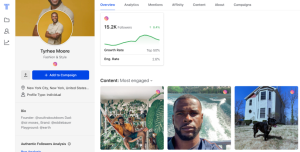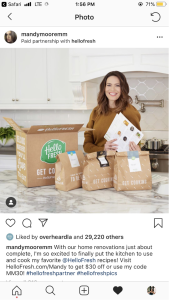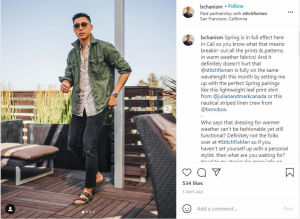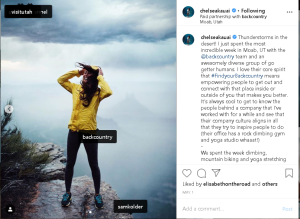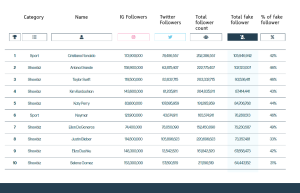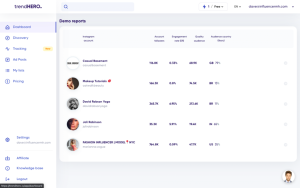Partnering up with the right influencers has the potential to become the key difference-maker. This is especially true when it comes to promoting your brand in front of new audiences. If you partner with an authentic influencer that aligns with your brand perfectly, their fans will gradually endorse your brand as well. These types of followers are much easier to turn into customers later.
However, if you partner with the wrong people, you can compromise your brand reputation for good. Fake influencers are a real danger, as we all know how easy it is to use bots to spam comments and buy fake likes and followers.
What’s more, even if the influencer isn’t fake, that doesn’t automatically make them a good fit for your brand. While their promotion won’t ruin your reputation, getting in front of the wrong audience will do you no good and will eventually waste your influencer marketing budget.
So, how to find influencers for your eCommerce brand?
This article will give you key parameters to look for when finding influencers. It will also outline five actionable steps that will help you partner with the right person. By the time you finish reading this post, you will know exactly what to do and have all the necessary information to start your influencer marketing campaign the right way.
But first, ask yourself: Who am I looking for?
Before we get to the actionable part and tactics that will help you find influencers, you need to ask yourself who the ideal influencer for your brand is. According to David Wachs, CEO of handwrytten ”Choosing influencers is not just about the reach they have. You must ensure that their values align with your brand’s values. Otherwise, you may drive customers away from your business.
This process is similar to determining an ideal buyer persona. In fact, your ideal buyers should be at the center of your influencer marketing efforts.
Before you even begin the search, you need to take a step back and establish the criteria and conditions your next influencer partner needs to meet:
Relevant audience
Many brands try to find influencers with the biggest profiles. This means nothing if the followers won’t have any interest in your brand.
The influencer you reach out to should have a “niche” audience that fits your brand well. The majority of their audience should mirror your ideal buyer persona.
For example, if you sell outdoor gear, it would make more sense to partner with a local Bear Grills than with a supermodel. While the rule isn’t set in stone, it’s always a good idea to reach out to local influencers first.
Even though the supermodel has a global reach, more followers, comments, and posts, they won’t have the right type of followers you are looking for. On the other hand, the outdoor guy will almost exclusively attract people who fit your buyer persona. Even if he has 50x fewer followers than the supermodel, each follower he brings to your brand is more likely to become a customer.
How to find influencers with a relevant audience
You should first start by searching through Instagram and Twitter hashtags relevant to your sub-niche and by Googling niche-specific keywords (we have more advanced Google search tips in Tip #4 below).
There are high chances are that you will still have too many results and will need to plow through the clutter a lot. There’s a better way to reach out to genuine thought leaders with the right type of audience.
If you want to take it to the next level and find influencers who are guaranteed to have a perfect follower base, look at major local or online niche events. If they happen periodically, go through speaker lists of past events, not just the upcoming ones.
Browsing through speaker lists will uncover a goldmine of potential collaborations with just the right type of people.
Some of the speakers might not have the biggest following, but getting paid to speak at major conferences means something. Be sure they have something to say, as well as enough people who respect their opinion. That alone makes them a fantastic potential partner that can make your brand stand out from the rest, showing credibility to the right audience.
Core values and brand alignment
Every influencer you reach out to should mirror your core values and align with your brand. After all, they are about to become your brand ambassadors. And you want to ensure they already represent everything you believe in.
While this sounds vague, you will be able to quickly discard people who don’t fit your brand even a little.
For example, if you sell cruelty-free outdoor gear, it would not make the slightest sense to partner up with a hunter, even though they spend all their time outdoors using equipment just like yours. Doing that would ruin your whole brand image instantaneously. This kind of mistake will discourage even your current customers from looking at any of your items in the future.
Partnering with a vegan outdoor enthusiast would be perfect for this particular case. Promoting your cruelty-free products won’t even look like a promotion. They are likely to already be using similar cruelty-free gear, making it easy for you to gain their audience’s interest.
HelloFresh has done an excellent job with their #hellofreshpartner influencer campaign. There, they partnered with micro-influencers (and celebrities, on some occasions) who are genuinely living a healthy lifestyle and ensuring their whole family eats quality food. That aligns perfectly with their core values as they try to provide a convenient way for whole families to enjoy and enjoy healthy food in the comfort of their homes. Partnering with this kind of influencer will also attract the right type of audience to their brand.
Credibility
It’s no secret that an influencer’s bread and butter is promoting products and brands. However, that doesn’t mean you should work with any influencer who is willing to take your money and promote your products.
Take a look at Brian Chan. He is a well-known influencer who focuses on menswear and style. His entire profile is devoted to clothing. So it makes perfect sense for him to partner with Stitch Fix and promote men’s fashion pieces. He has the authority to do so and his followers are much more likely to convert.
However, this isn’t the case with all influencers.
Sometimes, even if the influencer fits your niche perfectly and aligns with your brand well, working with them isn’t the best idea. Look at their past promotions and brands they worked with. If you notice they promoted some suspicious brands or products that aren’t a good fit for the niche or their follower base, that’s a strong signal they will promote next to anything if the money is right. In other words, it’s a signal they lack credibility.
Since your primary focus should be to build brand reputation and awareness, being picky when deciding who to partner with makes sense. Therefore, look through influencers’ past promotions and campaigns, and try to find red flags.
For example, let’s assume an outdoor influencer randomly promotes a course platform, a hosting company or a weight loss tea. Then you know something is not right. And if you can see that, so will their follower base, who probably won’t trust that influencer.
In fact, this type of low-credibility influencer will reach out to you all the time, especially as your brand and social media presence start growing. Even though their proposals might seem tempting, don’t gamble with your reputation – send a few thank you cards instead and politely refuse their offers.
Personality type
While going the safe route and trying to find an attractive, likable person makes sense for most brands, going for something a bit more exotic can achieve superior results in the right circumstances.
Take someone such as Gordon Ramsey as an example. We can’t say that all that yelling and swearing makes him the most politically correct, to say the least. But, if he recommends a brand, you can be sure that brand is a good one, as someone like Gordon doesn’t praise things very often.
While Gordon is one of a kind, there are still many personality types to choose from when trying to find a micro-influencer for your brand.
Let’s consider the example of Black Country’s partnership with Chelsea Kauai. Although this is a promotional post, it is very relatable and real. Chelsea shares a personal story with the brand, as well as their weekend adventures. Her vibrant personality shines so it’s easy for people to connect this feeling with the brand.
Remember – it’s not about the promotion, it’s about an authentic experience. If you manage to find an influencer whose personality type matches the emotion you want to evoke in people, your campaign has a great potential to succeed.
Engagement
While numbers alone, in terms of followers, comments, and likes, are not enough on their own and can sometimes be fake, engagement does matter. If an influencer gets a lot of engagement on their posts, it’s a good indicator that they know what they are doing.
Even if you look at some of the major celebrities and their accounts, it’s clear that they have a large percentage of fake followers. While this may not be a problem with Ellen DeGeneres or Ariana Grande (their base is genuinely huge), this could be an issue with smaller influencers. If 40% or more of their followers are fake, you won’t get the desired results with your campaign.
So, how can you avoid this scenario?
Once you identify influencers based on the criteria from above, start going through their posts. Don’t just focus on the number of likes and comments – look at the follower to comment/like ratio. If someone has 25k followers but only gets 100 likes per post, something isn’t right.
Also, look at the comments. Do they make any sense? What about profiles that leave those comments? Are those real people? Does the influencer reply to comments? Do followers engage with each other?
You should also look at post types, especially promotional ones. See if the influencer does reviews and comparisons, if they organize giveaways and prizes, and see how they promote products in their regular posts. Go through comments and notice if followers ask about products on the pictures and if the influencer is replying to their inquiries.
The whole goal of this research is to figure out how interested the influencer’s follower base is and how engaged they are in the discussions. You want to partner with scroll-stopping influencers who always get their audience’s attention and spark discussion – working with this type of individual will guarantee brand exposure.
How to spot fake influencers
Once you identify some interesting personas, you will need to perform some due diligence in order to make sure they are genuine influencers.
Use engagement formulas
If you want to do things manually, calculating the engagement rate is a good way to compare influencers. This formula goes:
Engagement rate = total engagement / total followers x 100
Total engagement is different for each platform. For Instagram, it would be the sum of all likes and comments. Facebook total engagement would represent likes, comments, reactions, and shares. Just make sure to use the same criteria when comparing influencers and do not mix platforms.
The engagement rate formula will immediately show some red flags. If someone has an engagement rate of less than one percent, you are probably dealing with a fake influencer. 1-3% is generally good, and if you find someone north of 3%, that person is worth reaching out to.
It is also worth calculating the average engagement rate of more recent posts, especially if the influencer has been around for a long time and has a large following.
Sum up all of their posts from the past month, and calculate the average engagement rate per post by dividing the summed engaged rate by post with the number of posts released within that month. That will tell you how their recent content performs. You can do this for the daily engagement rate too.
Go through comments
If you want to ensure you are dealing with real influencers manually, you will need to do some grunt work and go through posts and read comments.
Focus on spammy, bot-like comments that seem not to have anything related to what’s on the post itself. Short, one or two worders, emoji-only comments should raise red flags. More importantly, an abundance of comments from one follower with zero interaction from other followers and no interaction between the influencer and their follower base are signs that you need to move on.
Keep in mind that fake comments show up on all profiles. So don’t label an influencer as fake immediately after you spot some fake comments. Large profiles can have up to 30% of fake comments. But, the chances are you are not planning to reach out to Kim anytime soon – if a micro-influencer with 5k followers gets 35% of fake comments, something is not right.
Influencer tools can help
Influencer search tools can help you get through the pedestrian work of spotting fake influencers a bit easier. Most of these tools have built-in engagement formulas, and they give you automatic, algorithm-based estimates that tell you how many followers/comments are fake.
Some of the more popular fake influencer search tools are trendHERO, Social Blade, and IG Audit.
Remember that these tools aren’t perfect, as they give you estimates that aren’t set in stone. At the same time, they will cut out some obvious fake influencers, so you don’t have to do everything manually. Just make sure to go through the top picks and ensure that the tool indeed made the correct estimate.
How to find influencers for your (eCommerce) brand
Following the tips from above will ensure you contact only real influencers who are a great fit for promoting your brand. Knowing what to look for will make your job easier, but you still need to do the work and reach out to potential partners.
Fortunately, we have some tips that will help you with the actual search and help you find relevant influencers in the shortest time possible.
#1 Reach out to influencers who already interact with your brand
If someone is already mentioning your brand either by using your hashtags, putting your brand in their posts, or constantly sharing your updates and participating in discussions, they are an ideal candidate for a partnership.
This type of person already loves your brand and promotes it without sponsorships. If you start collaborating, their promotions will look natural and not forced.
What’s more, this person is much more likely to fit your brand values and align with them, which is an essential criterion. If they have a healthy profile with good engagement, you should give them a go, even if they don’t have the biggest following.
Additionally, reaching out to micro-influencers like this has enormous potential. If they are just starting to gain traction, your brand will grow with their profile, and they won’t be as demanding as some other, more established influencers. This gives you great value for your investment.
#2 Scan competitors’ collaborations
Keeping an eye on the competition is a wise move in influencer marketing. Monitoring your competitors’ online presence will tell you a lot about their seriousness and ensure you don’t stay behind.
Monitor what your competitors are doing, and pay close attention to their influencer collaborations. Try to figure out how they selected the influencers they are working with, and think about what you can apply to your brand and what you think you can do better. Look at their influencer partners, and see if they would fit your brand based on the criteria we established in the section above.
Don’t focus solely on influencers as persons; analyze the influencer campaigns as well. Check the types of promotional posts that have the best engagement and see if those can fit within your future campaign.
Look at the tags and brand mentions as well as the hashtags influencers use. Searching through those will not only give you great ideas but might uncover other relevant influencers you can reach out to.
While scanning competition is an excellent way to get ideas and inspiration, reaching out to the same social media influencers usually isn’t a great idea. Even if the influencer hasn’t signed a contract that prohibits them from working with competition, partnering with them won’t send the best message. If an influencer is willing to promote several brands within the same niche only if the money is right, they probably lack credibility.
On the other hand, if you find social media influencers that fit your brand perfectly, and haven’t worked with any of your competitors yet, consider signing an exclusive deal. That will prevent them from working with your competition, making them a genuine ambassador of your brand. Finders keepers!
#3 Keep an eye on niche hashtags, keywords, and locations
Every niche has its jargon, and slang fans use when communicating with each other. It’s your job to stay current and monitor relevant keywords, mentions, and hashtags your target audience uses.
Staying on top of niche terms and locations will uncover potential influencer partners and help your social media marketing as a whole. Including niche terms in your social media posts will signal to your audience that you are one of them and not just an intruder who doesn’t understand their language, which would make it impossible to understand their needs.
Finding niche terms that fit your brand will help you filter individuals who are deeply invested in the field and therefore more likely to be a better fit.
For example, if you sell weightlifting accessories, browsing through #fitness would be way too broad. But, if you want to promote your wrist straps, something like #biglifts or even #powerlifting will be much more specific, as it will list people who lift heavy and attract the right type of followers.
It’s also good to keep track of niche-specific locations and check-ins. In our previous example with cruelty-free outdoor gear, it would make sense to keep an eye on any mention of a challenging local mountain peak. Whenever someone tags themselves there, and posts how they have conquered that climb, check their profile – if they have a following, they are likely to be a good match.
#4 Google search popular niche blogs and YouTube channels
If you know the niche terms and slang for your industry, it won’t be hard to find blogs and YouTube channels that belong in the same sphere. In fact, the influential blogger’s specialty is ranking high for niche keywords, as most of them rely on affiliate commissions and sponsorship deals. For that reason, it won’t be too difficult to find popular blogs. – They will rank high for relevant niche keywords. All it takes is you doing a quick Google search for niche-specific terms, and you are likely to find a popular blog post written by a potentially perfect influencer to partner with.
The same applies to finding popular YouTubers within your niche. You only need to search for tutorials and video demonstrations relevant to your target audience. By doing this, you will uncover creators who specialize in the type of content that is perfect for your brand.
What’s especially great about bloggers and YouTubers is that they create evergreen content. Most Instagram posts have a very short lifespan, as people only want to see the newest thing on their feed. Even if they open a profile, they are unlikely to look through its whole history.
Blogs and YouTube videos are exactly the opposite. Creators know they should rank for evergreen terms, which will keep getting them traffic/views for years to come. If your brand or products end up in one of their posts, it will continue to get exposure as long as their content stays relevant.
When you combine this with the fact that both bloggers and YouTubers always try to improve their rankings, their SEO improvements will benefit your brand too. The higher they get in the search results, the more people will see their content and your brand mentioned in it.
#5 Influencer search tools
Influencer search tools such as Trendhero, BuzzStream, or Upfluence are designed to make your search much easier and faster. Influencer marketing platforms will list social media influencers based on your queries and allow you to compare them and spot fake or boosted profiles. They also have special filters which will let you quickly find the right people based on audience demographics, activity, engagement, and more.
However, there are some issues with specialized influencer marketing platforms. First, they are not miracle solutions, which means you will still need to go through the profiles and ensure the suggestions meet all of the essential criteria you established. Second, if you want to use better tools to their fullest, you will need to pay for the premium version of the influencer marketing platform. This adds another monthly fee to your expenses list.
Bottom line
If you follow the advice from this article and focus your efforts on establishing the right criteria before reaching out to anyone, your influencer marketing campaign will be a success.
How you approach the target influencer is just a technical question – whether it’s going to be through niche hashtags, blogs, or by taking inspiration from your competition is up to you.
But, if you did all of the above right, each person you partner with will align with your brand perfectly. They will have the right type of loyal fanbase ready to embrace your products immediately, making your influencer marketing campaigns a homerun.

